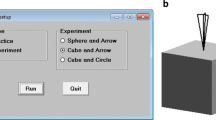Abstract
Background
This study addresses how high-level visual-spatial ability of surgical novices is related to performance of two simulator tasks with (KSA) and without (MIST) anatomic graphics and haptic feedback, differing in visual-spatial complexity.
Methods
Visual-spatial test scores assessed by Mental Rotation Test (MRT) and BasIQ and performance scores for Instrument Navigation (IN) in Key Surgical Activities (Procedicus KSA) and Manipulate and Diathermy (MD) in Minimally Invasive Surgical Trainer (Procedicus MIST) were correlated for 54 Swedish surgical novices.
Results
Significant Pearson’s r correlations were obtained between visual-spatial scores measured by MRT-C and total score from the last trial for IN (r = 0.278, p < 0.05). Visual-spatial scores (measured by BasIQ) also correlated with total score from the first trial (r = 0.443, p < 0.05) and from the last trial (r = 0.489, p < 0.05).
Conclusion
High-level visual-spatial ability is important for surgical novices to possess in the early training phase of a visual-spatial complex task in KSA.

Similar content being viewed by others
References
Borg G (1998) Borg’s perceived exertion and pain scales. In: Human kinetics. Champaigne, IL, pp 30–67
Carpenter PA, Just MA (1986) Spatial ability: An information processing approach to psychometrics. In: Sternberg RJ (ed) Advances in the psychology of human intelligence. Erlbaum, Hillsdale, NJ, pp 221–253
Cuschieri A (1995) Whither minimal access surgery: tribulations and expectations. Am J Surg 169: 9–19
Ekstrom RB, French JW, Hartman HH, Dermen D (1976) Manual for kit of factor-referenced cognitive tests. Educational Testing Service, Princeton, NJ, Champaign, IL
Gallagher AG, McClure N, McGuigan J, Ritchie K, Sheehy NP (1998) An ergonomic analysis of the fulcrum effect in the acquisition of endoscopic skills. Endoscopy 30: 617–620
Gallagher AG, Richie K, McClure N, McGuigan J (2001) Objective psychomotor skills assessment of experienced, junior, and novice laparoscopists with virtual reality. World J Surg 25: 1478–1483
Ghani JA, Deshpande SP (1994) Task characteristics and the experience of optimal flow in human-computer interaction. J Psychol 128: 381–391
Gustafsson J-E (1998) Hierarchical models of individual differences in cognitive abilities. In: Sternberg RJ (ed) Advances in the psychology of human intelligence. Lawrence Erlbaum Associates, Hillsdale, NJ, pp 35–71
Lohman DF (2000) Complex information processing and intelligence. In: Sternberg RJ (ed). Handbook of intelligence. Cambridge University Press, New York, pp 285–340
Macmillan AI, Cuschieri A (1999) Assessment of innate ability and skills for endoscopic manipulations by the Advanced Dundee Endoscopic Psychomotor Tester: predictive and concurrent validity. Am J Surg 177: 274–277
Mountcastle VB (1998) Perceptual neuroscience: the cerebral cortex. Harvard University Press, Cambridge, MA
Mårdberg B, Sjöberg A, Henrysson-Eidvall S (2000) BasIQ begåvningstest: manual. Psykologiförlaget, Stockholm, Sweden, pp 47–55
Peters M, Laeng B, Latham K, Jackson M, Zaitouna R, Richardson C (2000) A redrawn Vanderberg and Kuse mental rotation test: different versions and factors that affect performance. Brain Cogn 28: 39–58
Risucci D, Geiss A, Gellman L, Pinard B, Rosser J (2001) Surgeon-specific factors in the acquisition of laparoscopic surgical skills. Am J Surg 181: 289–293
Roethlisberger FJ, Dickson WJ (1946) Management and the worker. Harvard University Press (1939) xxiv. Oxford, England, p 615
Rosser JC Jr, Rosser LE, Savalgi RS (1998) Objective evaluation of a laparoscopic surgical skill program for residents and senior surgeons. Arch Surg 133: 657–661
Salas E, Cannon-Bowers JA (2001) The science of training: a decade of progress. Annu Rev Psychol (2000): 471–499
Satava RM, Cuschieri A, Hamdorf J (2003) Metrics for objective assessment. Surg Endosc 17: 220–226
Satava RM, Gallagher AG, Pellegrini CA (2003) Surgical competence and surgical proficiency: definitions, taxonomy, and metrics. J Am Coll Surg 196: 933–937
Senn S (1993) Cross-over trials in clinical research. Wiley, Chichester, England
Seymour NE, Gallagher AG, Roman SA, O’Brien MK, Bansal VK, Andersen DK, Satava RM (2002) Virtual reality training improves operating room performance: results of a randomized, double-blinded study. Ann Surg 236: 458–463; discussion 463–464
Sidhu RS, Tompa D, Jang R, Grober ED, Johnston KW, Reznick RK, Hamstra SJ (2004) Interpretation of three-dimensional structure from two-dimensional endovascular images: implications for educators in vascular surgery. J Vasc Surg 39: 1305–1311
Strom P, Kjellin A, Hedman L, Johnson E, Wredmark T, Fellander-Tsai L (2003) Validation and learning in the Procedicus KSA virtual reality surgical simulator. Surg Endosc 17: 227–231
Strom P, Kjellin A, Hedman L, Wredmark T, Fellander-Tsai L (2004) Training in tasks with different visual-spatial components does not improve virtual arthroscopy performance. Surg Endosc 18: 115–120
Taffinder N, Sutton C, Fishwick RJ, McManus IC, Darzi A (1998) Validation of virtual reality to teach and assess psychomotor skills in laparoscopic surgery: results from randomised controlled studies using the MIST VR laparoscopic simulator. Stud Health Technol Inform 50: 124–130
Wanzel KR, Hamstra SJ, Anastakis DJ, Matsumoto ED, Cusimano MD (2002) Effect of visual-spatial ability on learning of spatially-complex surgical skills. Lancet 359: 230–231
Wanzel KR, Hamstra SJ, Caminiti MF, Anastakis DJ, Grober ED, Reznick RK (2003) Visual-spatial ability correlates with efficiency of hand motion and successful surgical performance. Surgery 134: 750–757
Wanzel KR, Ward M, Reznick RK (2002) Teaching the surgical craft: from selection to certification. Curr Probl Surg 39: 573–659
Acknowledgments
This research was supported by research funds at the Karolinska Institutet and Huddinge University Hospital and Grant 220-155600 from EU Goal1: North of Sweden. The sponsors had no role in this study. We thank Lars Särnå and Kai Mäkinen (biomedical engineers) at the Department of Biomedical Engineering, Karolinska University Hospital, Sweden, for excellent technical assistance.
Author information
Authors and Affiliations
Corresponding author
Rights and permissions
About this article
Cite this article
Hedman, L., Ström, P., Andersson, P. et al. High-level visual-spatial ability for novices correlates with performance in a visual-spatial complex surgical simulator task. Surg Endosc 20, 1275–1280 (2006). https://doi.org/10.1007/s00464-005-0036-6
Received:
Accepted:
Published:
Issue Date:
DOI: https://doi.org/10.1007/s00464-005-0036-6




